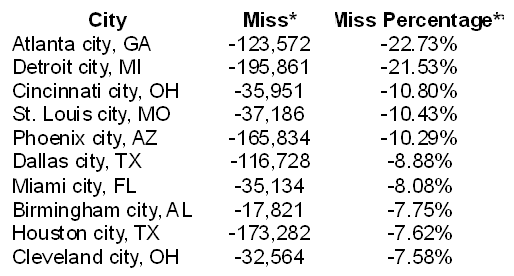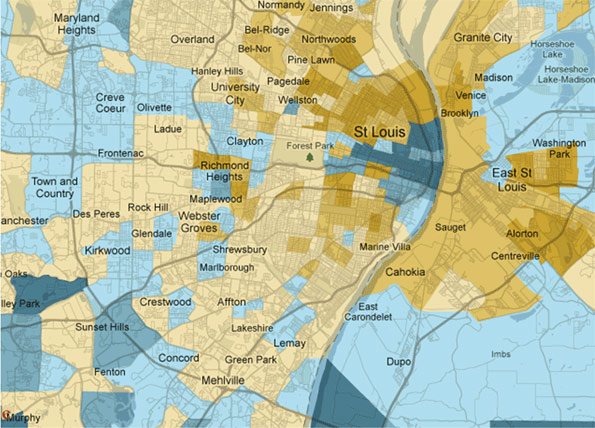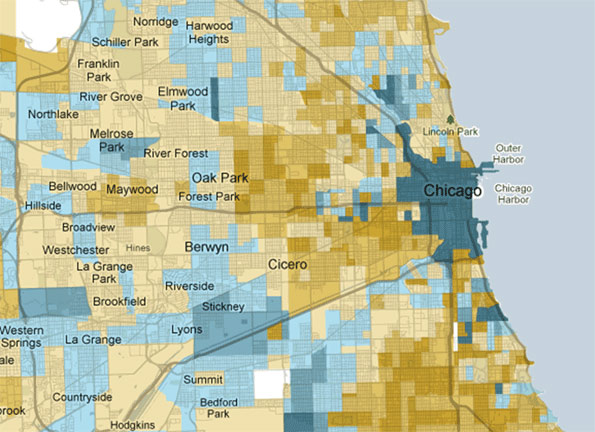Much has been made of the vaunted ?back to the city? movement by ?the young and restless,? young professionals, the creative class, empty nesters and others were voting with their feet in favor of cities over suburbs.� Although there were bright spots, the Census 2010 results show that the trend was very overblown, affecting mostly downtown and near downtown areas, while outlying ones bled population.� One culprit for this discrepancy seems to be that the intra-census estimates supplied by the Census Bureau were inflated ? in some cases very inflated.
Looking at selected core cities for major US metropolitan areas, many of them were materially over-estimated:

One particularly egregious case relates to Atlanta. Its huge projected population increase in the 2000s led me to describe it as ?one of America's top urban success stories.?� The reality proved to be quite different. Rather than strong population growth in the city, the population growth turned out to be basically flat, quite a different story.� Other declines might be more predictable, such as Detroit, or those who had previously challenged estimates like Cincinnati and St. Louis.� Still, even urban cores in rapidly growing regions like Dallas and Houston were not immune from this trend.
There were some exceptions. Cities like Indianapolis, Columbus, and Oklahoma City came in slightly ahead of expectations, but the number of cities with misses and the sizes of the positive and negative misses tilted towards the down direction.
It seems clear now that the justification for much of the ?back to the city? story reflected bad estimates. People can't be faulted for relying on the official government numbers ? I did. But the reality of the 2010 Census, as demonstrated by Wendell Cox and others, is that the 1990s were actually better for urban population growth in America than the 2000s in many respects.
One legitimate bright spot for cities lay in the growth of downtown and near downtown areas.� Though often starting from low bases, these areas often showed impressive increases.� For example, St. Louis showed good growth downtown despite a very disappointing decline in total city population:

The poster child for this phenomenon was Chicago, where a fairly expansive area in the greater core showed large population growth.� Areas that were formerly almost all commercial, such as the Loop, added significant residential population, while areas that were nearly derelict like the near South Side have blossomed into thriving upscale neighborhoods.

The problem, from places ranging from Chicago to Cleveland, is that the gains in the ?core of the core? have been more than offset by losses elsewhere, especially the flight of blacks and other minorities ? many of them immigrants ? to the increasingly diverse suburbs.
Cities across America have invested enormous sums into downtown redevelopment and major projects in selected districts.� The good news: these investments have shown some ability to move the needle in terms of attracting young professionals downtown.� The bad news lies with the fact that these developments have been extremely costly, and have not transformed the overall demographic or economic climates of the cities that tried them.� This demonstrates the limits of the policies.� Those who aren't in the young professional, empty nester, or creative class demographic have rightly figured out that they are no longer the target market of city leadership. No surprise then that many of them��� have decided to vote with their feet.
Given the resulting overall negative swings, cities may want to revisit their strategy of putting all their chips in the downtown redevelopment basket in favor of less glamorous improvements in basic neighborhood safety, services, schools and other critical elements.� A handful of elite enclaves and talent hubs may be able to thrive on a ?favored demographic quarter? strategy, but for most places there just aren't enough young professionals and artists to go around.
Aaron M. Renn is an independent writer on urban affairs based in the Midwest. His writings appear at The Urbanophile.
* Actual population minus projected population as of 4/1/2010 using a run rate projection based on the 2008-2009 estimated population growth.
** Base is the projected 4/1/2010 population above.
Photo by Ian Freimuth
Full story at http://feedproxy.google.com/~r/Newgeography/~3/HUHhGuYG3hk/002202-rethinking-urban-dynamics-lessons-census










No comments:
Post a Comment